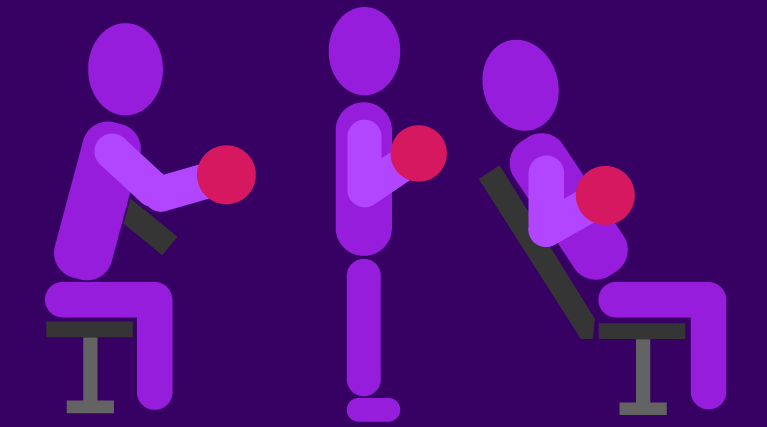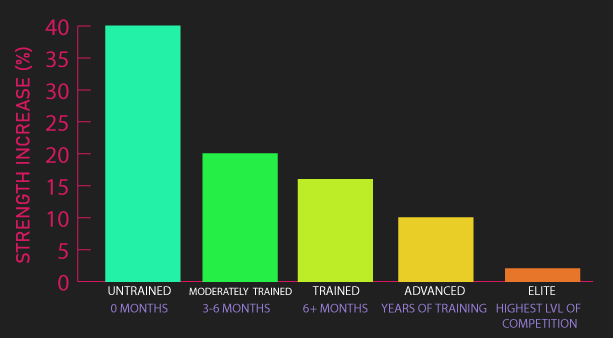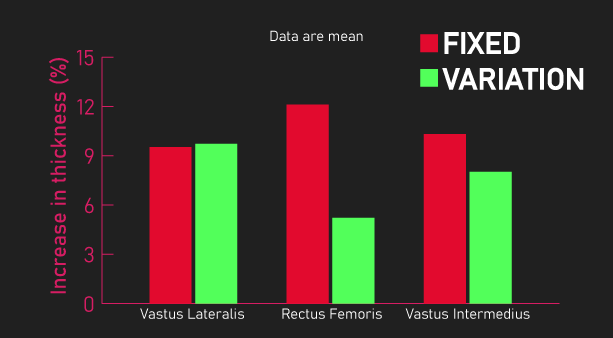
In this article, we aim to figure out if you’re missing out on more muscle growth by not changing your exercises every session.
Table of Contents
Part I: Muscle Confusion Theory
Accommodation is considered a general law of biology.
As per the science and practice of strength training, the response of a biological object to a constant stimulus decreases over time.
Applying this to resistance training, training with the exact same routine will incrementally produce fewer and fewer gains.
Now, regardless of how you train, the amount of gains you can experience diminishes over time.
The amount of gains you experience in your first two years of consistent training is going to be greater than the gains experienced in the subsequent two years.
For example, Kraemer et al. evaluated around 140 studies and established this relationship between training experience and strength gains (shown in the graph below). The longer you’ve been training, the less strength gains you experience.

Similar trends likely exist for building muscle.
Nevertheless, the law of accommodation still suggests your body becomes non-response quicker when training with the exact same routine long-term.
In an attempt to counter this accommodation, one extreme response is to change the exercises you perform every single session.
This is known as muscle confusion in the bodybuilding world.
It’s hypothesized changing exercises every session exposes your muscles to consistent novel stimuli, thus limiting any accommodation that may diminish muscle growth.
Though this sounds nice in theory, does it play out in reality?
Does changing exercises every session enhance muscle hypertrophy?
A Spanish study by Baz-Valle et al. is the only study I’m aware of examining this.
Part II: Baz-Valle et al.
The researchers recruited 19 men with at least 2 years of training experience, who back squatted an average of 123kg and bench pressed an average of 94kg.
The subjects were assigned to either a fixed or variation group.
Both groups performed two upper body and two lower-body training sessions per week for 8 weeks.
The fixed group performed the same 6 upper body exercises on their upper body days (bench press, pendlay row, shoulder press, latpulldown, dumbbell fly, dumbbell pullover), and the same 6 lower body exercises on their lower body days (back squat, deadlift, leg press, hip thrust, leg extension, leg curl).
The variation group used a phone app consisting of 80 different exercises to randomly generate what exercises they trained with. On the upper body days, the phone app generated 3 pulling and 3 pushing exercises. On the lower body days, the phone app generated 3 anterior chain and 3 posterior chain exercises.
Of course, this likely meant the variation group was changing exercises every session and probably not that frequently performing the same exercise.
Both groups, on all their exercises, performed 3 sets of 6 to 12 repetitions to failure.
Before and after the study, thickness of the rectus femoris, vastus intermedius, and vastus lateralis was measured at approximately 50% of the thigh bone length via ultrasound.

it was found increases in thickness of all three of the muscles were not statistically different between the fixed and variation groups.

Now, some of the percentages seem to favor the fixed group, especially the rectus femoris percentage gains.
Did the small sample sizes of the study compromise the ability to detect this percentage change as statistically significant, something we call a type 2 error?
Or maybe it was that small sample sizes introduced large variation. For instance, the subjects in the fixed group might have just so happened to have better average rectus femoris muscle-building genetics.
In any event, this study fails to qualify as evidence that changing exercises every session enhances muscle hypertrophy.
Before moving on, if you’re curious about creating an effective training program for muscle hypertrophy, our high quality partner Alpha Progression can help. It can generate a highly effective program for you, track your workouts live with in-built progression recommendations, provide graphs displaying your long term progress, and it has a massive exercise database with more than 550 exercises.
Click HERE (the link opens in a new tab) to get a free 2 week trial of the apps features. If you like it and go beyond, the link also gives you 20% off a subscription!
We never promote trash at the House of Hypertrophy, so rest assured the app is high quality. The reviews speak to this, 4.8 starts (based on more than 7,000 reviews) on Google play, and 4.9 stars in Apple’s store (based on nearly 400 ratings).
Part III: Motivation levels
The researchers found through a questionnaire handed to the subjects, the variation group saw increased motivation levels to train throughout the study, whereas the fixed group’s motivation levels slightly declined.
As a result, if the study does truly suggest there’s no difference between fixed and variation training (there were no type 2 errors), then this is evidence changing exercises every session may be a viable way to enhance motivation levels while not compromising muscle growth.
Part IV: Some Considerations
Despite this study’s findings, I think it’s worth touching on three potential considerations with changing exercises every session.
Firstly, many exercises (particularly compound exercises) are skills.
Regular practice of an exercise is required to achieve smoother and more efficient movement, something that would ensure we’re stimulating the intended muscles most effectively.
Changing exercises every session can prevent or significantly delay exercise skill acquisition. This may be more so a problem for individuals with minimal training experience.
Secondly, changing exercises every session might require longer recovery durations than training with fixed exercises, at least in the long term.
Allow me to explain.
The amount of muscle damage present is one factor that determines whether you’re recovered between sessions.
When you first expose yourself to a novel training routine, the amount of muscle damage produced afterward is quite high. But as you continue to expose your body to the same training routine week after week, the amount of muscle damage produced afterward incrementally decreases.
This is thanks to a range of adaptations within the muscles called the repeated bout effect.
The repeated bout effect is going to be greater when performing the same weekly exercises in your training routine.
Most people have experienced this. When performing the same weekly training routine, the amount of soreness you experience gradually diminishes over many weeks of training, and you’re overall recovery capacities become better.
However, If you’re changing the exercises you perform every session, the repeated bout effect likely occurs to a lower extent. It’s likely your recovery durations are going to always be longer compared to training with the same weekly routine.
Now, in the Baz-Valle et al. study, evidently recovery was not a problem for the variation group, as the variation and fixed group’s gains were not statistically different from one another.
But it’s worth noting the study used an upper/lower split, in which the same muscle was trained 72 hours apart.
However, what if something like a full-body split was used, in which the same muscle is mostly trained 48 hours or quicker apart? Would the variation group appropriately be able to recover long-term?
It’s difficult to say without future research.
Another point worth adding is there’s evidence gradually increasing the number of weekly sets you perform for a muscle group might be an effective way to get past plateaus. We overviewed this evidence in our ultimate guide to sets article.
Of course, increasing set numbers requires you can tolerate and recover from this increased volume. This might be harder to do when changing exercises every session.
The third consideration with changing exercises every session relates to tracking progression.
When performing the same weekly exercises, so long as you’re able to progressively overload them in some form (either via increasing load or repetition numbers), you have proof you’re progressing.
Furthermore, if you’re not progressing with your fixed exercise selection in the way you expect, this can be an indicator something’s wrong, and it allows you to re-assess your training plan and make adjustments.
In other words, fixed exercise selection can help you individualize and optimize your training routine in the long term via more meticulous tracking.
When changing exercises every session, you can simply perform repetitions to or very close to failure on them, which ensures you’ve provoked a good stimulus. However, the fact is it’s very difficult to tell if you’re making progress week to week. If you hit a plateau, it’s going to be difficult to establish this.
Part V: Takeaways
We currently have one study by Baz-Valle et al. finding changing exercises every session was comparable for muscle growth to training with fixed exercises.
Despite this, I think there are some potential issues with changing exercises every session.
Firstly, for those with minimal training experience, changing exercises every session can prevent or at least significantly delay the development of form and skill with exercises.
Secondly, over the long-term, changing exercises every sesion probably requires longer recovery durations than training with the same exercises, this might make it unpractical when training with full-body splits that require you to recover within 48 hours or less. Moreover, it may also make it challenging to increase volume in the long term, and increasing volume may be helpful for getting past plateaus.
Finally, changing exercises every session makes it difficult to track progression and very challenging to establish if you’ve hit a plateau.
Remember to feel free to check out the Alpha Progression App if you’re interested. Also feel free to check out our free bench press e-book below.

